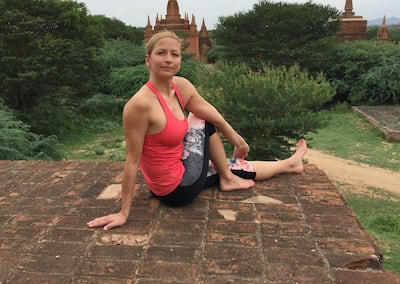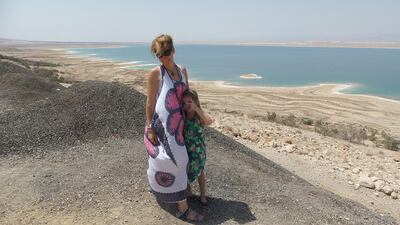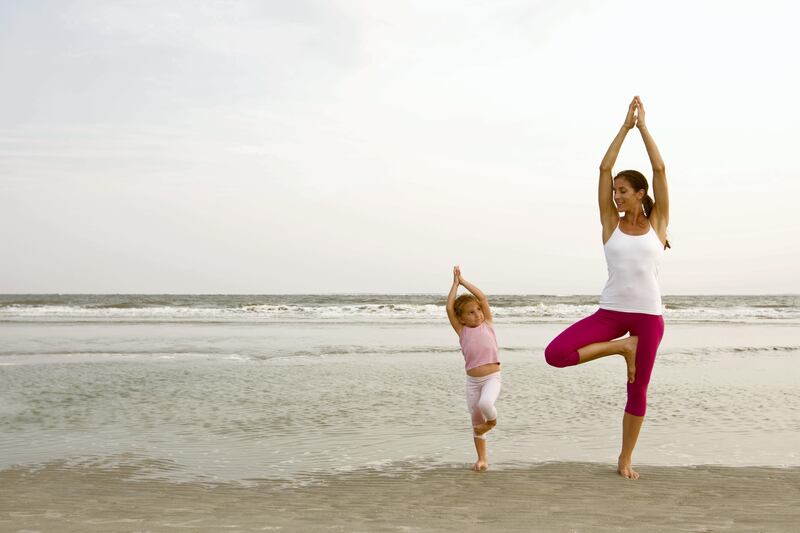It was about eight years ago that Dr Pankaj Shrivastav tagged along to a hatha yoga class with his wife, who is a regular practitioner.
Shrivastav, director of Conceive Gynaecology & Fertility Hospital in Sharjah, was curious after reading studies about how yoga reduced stress.
He watched as the students moved through poses designed to loosen connective tissue and tight muscles, and increase blood flow to the key reproductive areas of the hips, groin and pelvis, and he could see them relax, particularly when engaged in deep-breathing exercises.
Since then, Shrivastav has encouraged his patients undergoing stressful fertility treatments to incorporate yoga into their lifestyle. "Not only does it promote well-being and self-healing," Shrivastav says, "but it helps in preventing weight gain from the artificially injected hormones."
While there isn't scientific research directly linking regularly practising yoga to increased fertility, the connection is "logical", he says. That's because there is a growing intersection between scientific studies showing how higher levels of fight-or-flight stress hormones can negatively affect fertility, and those using brain scans and other methods to explain some of the mental and physical benefits of yoga that practitioners have spoken about for years.
On the yoga side, a paper published in the June issue of Frontiers in Immunology analysed the findings of 18 studies involving almost 1,000 people, and found that those who practised mind-body exercises like yoga, meditation and concentrated breathing had fewer signs of inflammation, increasingly suspected to be at the root of many physical and mental issues.
In 2010, in a study published in the Journal of Alternative and Complementary Medicine, researchers at Boston University Medical School used an MRI to record a 27 per cent increase in gamma-aminobutryic acid (Gaba) in a group of eight experienced yoga practitioners, after an hour, compared to a control group asked to read quietly. Irregular levels of Gaba, a mood regulator, have been linked to an increased risk of anxiety and depression. And on the stress side, a 2011 study published in the American Society for Reproductive Medicine journal Fertility and Sterility tested the saliva of 274 women between the ages of 18 and 40, who were trying to get pregnant. It found that those with high levels of the body's stress hormone cortisol, as well as alpha-amylase, which is an enzyme that circulates in a body under stress, had a 12 per cent reduction in their ability to conceive. Levels of adrenaline, another stress hormone, have also been found to be higher in women with unexplained fertility problems.
Higher levels of these hormones can also lower sperm count, studies show, meaning regular yoga practice can help men boost fertility as well.
Dr Nas Al Jafari is a family medicine consultant and one half of the team behind Intercare Health Centre, a family medicine centre located in Al Marina, Abu Dhabi, which shifts the healthcare focus from disease treatment to wellness and prevention.
"Yoga and meditation work by reducing your cortisol, so you're controlling your emotional stress," he explains. "So it improves sleep quality as well, if you're more relaxed and you're doing it in the evening. And also yoga is a form of exercise, so muscle stimulation and exercise in very simple terms just means your cells become more efficient at producing energy, which balances your hormones."
There are many factors that play into rising infertility rates, he explains, including our increasing disconnection from nature, chronic stress and ever-present devices that interrupt our day-night rhythms, harming sleep, and wreaking havoc on our hormonal systems, biological processes and cell function.
"The knee-jerk reaction is to put women on these hyper- stimulant hormones to try and produce an egg," says Al Jafari. "It's all about the key words, isn't it? No one's really identifying the under-lying problem."
In the West, fertility specialists and the yoga community are increasingly forming partnerships, and groups such as Chicago-based Pulling Down the Moon, a holistic health group that serves two of the largest fertility centres in the country. In addition to offering six-week yoga programmes, Pulling Down the Moon is working with Fertility Centres of Illinois to measure the impact of yoga on anxiety levels and pregnancy rates after assisted reproductive technology has been used unsuccessfully. The group is following up a previous study, which found that yoga sessions reduced anxiety levels in infertility patients by 20 per cent.
In the UAE, fertility clinics and hospitals are also recognising the impact that yoga can have on boosting fertility, linking up with yoga studios and teachers to provide sessions for clients.
British expat Mia Man is one half of YogaBellas, which has been working with Bourn Hall Fertility Centre in Dubai to offer patients yoga classes, workshops and other coaching sessions on the recommendations of its medical staff.
Man, who, at 35, is pregnant with her second child, believes that in addition to regulating hormonal imbalances and increasing blood flow, yoga can help no matter what infertility scenario a woman is facing. "It does just naturally cause stress. You think: 'What's wrong with me?'" she says. "And yoga is just a toolbox to support and give you some control over feelings, thoughts, and just being mindful to everything, mindful to your sleep patterns, mindful to your eating. It just sort of sets the foundation for a healthier start."
Katerina Maskova, who is new to the UAE from the Czech Republic, is a Hormone Yoga Therapy (HYT) instructor giving two workshops on the method in Abu Dhabi next month. She is also in talks to form a partnership with a fertility clinic in Dubai.

"I'm really happy, because more doctors are starting to be open to the holistic thing, when before it was no way," says Maskova.
HYT, which was developed by the Brazilian psychologist and yoga teacher Dinah Rodrigues, uses a combination of yoga asanas, or exercises, to reactivate hormone production and address imbalances. The moves are combined with pranayama, or breathing techniques, visualisation and relaxation into a half-hour practice designed to be done daily. Maskova teaches the method during an eight-hour, two-day workshop. "I have friends who are against these more holistic approaches and I always say: 'You know what? It costs you nothing, 30 minutes a day and it can really help you,'" says Maskova. "So give it a chance, one month, two months, and you can really start to feel it. Even though you won't get pregnant in two weeks, you will really feel much better. It helps you keep going."
Amelia Webb, a yoga teacher from London who is on her second maternity leave, taught fertility yoga classes for several years at Zen Yoga in Dubai. The classes were designed to help both men and women understand their bodies better, as well as reduce tension and balance hormones.
While all that is possible, she provided this caution: "If you have a serious medical issue, yoga is not going to magic it away. There's still going to be a problem there."
Andrea Balazs, a yoga teacher and fertility and pregnancy coach who recently moved back to Hungary after 10 years in Dubai, now conducts Skype workshops from her home with women undergoing IVF, as well as those planning to or trying to get pregnant. Balazs, who has polycystic ovarian syndrome (PCOS), credits yoga, cleaning up her diet and cutting out sugar with conceiving naturally after three-and-a-half years of trying. Her daughter, Laura, is now six years old.

Balazs also teaches the Aviva Method, which is a 30-minute sequence of dance moves – most involving a pelvic tilt and squeeze – designed to improve the blood flow and provide a boost to fertility.
She believes increasing blood flow throughout the body and to the reproductive areas is key to boosting fertility, particularly in our sedentary society.
"At least take 20 minutes when you come home from work, and even put your legs up the wall, because the blood flow will go directly to the area. Especially if you are doing a sitting job where you sit at the desk all day and you don't even get up, everything is energy stagnant," says Balazs. "You need to increase the energy in the abdominal area, and throughout the body, to create a life."
Couples should always go the medical route if there are issues, says Balazs, but complement treatment with yoga or other relaxation methods.
"I'm very pro-natural, so I always say go natural first. Do whatever you can do to make it happen naturally," she says. "Because we are designed
to do this, so there must be a way."
_______________
Read more:
[ Review: Swinging to fitness with AntiGravity Yoga ]
[ The road to wellness: catching up with Bodytree Studio founders Sharifa and Nadia Sehweil ]
[ Where to go for rehabilitative Pilates in the UAE ]
_______________






